Monday, 4 January 2016
There is an old story, which is most likely an urban myth, about a frog in slowly heated water. And people, please don’t try this at home, frogs are alright by me! The story goes along the lines of the frog being placed in a pot of water which is slowly heated. The frog doesn’t appear to notice that water that it is living in is slowly heated, until eventually the water becomes too hot for the frog and it either bounces out of the pot (nice work!) or it may die.
I feel exactly like that frog because the summer is the hottest summer that I can recall and everyday my workload has been slowly increasing due to the need to maintain the food plants that are suffering because of those hot conditions. It was the editor who finally pointed out to me earlier this week just how much of each day that I’d been spending maintaining all of the various plant systems here.
Something had to give.
So long as the plants have adequate water, the heat is making them jump out of the ground and Tomato Cam™ shows just how much growth has occurred over the past week:
 |
| Tomato Cam™ shows just how much growth has occurred here due to the extraordinary heat |
I still have a reasonable quantity of water stored due to the recent rains, so I’d been watering those tomatoes by hand every single day – as well as all of the other annual food plants (excluding the fruit trees in the orchard which are doing fine, so far) on the farm. There are however, other projects calling for my attention and I can’t do everything. So this week, after a short brain storming session, the editor and I purchased some sprinklers.
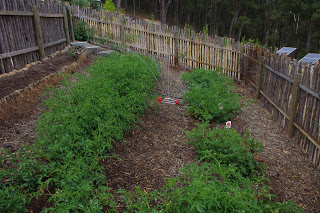 |
| A sprinkler now provides a couple of minutes water to the tomato and blackberry beds saving me a lot of time each day |
The problem with sprinklers is that when you turn them on, you have to remember to turn them off again. On one particularly hot day this week when the temperature in the shade was pushing 40’C (104’F), I ran a sprinkler in the chicken run to provide some temporary cooling for the chickens. I then forgot to turn that sprinkler off and almost completely drained the chicken’s water tank. Well done me!
The other interesting thing about accidentally dumping so much water (well over 1,500 litres / 400 gallons) into the chickens deep litter mulch is that the bacterial action in that deep organic material is making the litter feel quite warm to touch!
The project that has received the most attention this week is the conversion of the old chicken shed into a much sturdier firewood shed.
I’m mildly embarrassed at how cobbled together and leaky the old chicken shed actually was, but fortunately for the chickens they are now in a very nice – albeit temporarily damp – fully enclosed and completely weather and vermin proof steel chicken enclosure shed and run. They’re very happy – although mildly annoyed because of the damp!
Back to the story of the conversion of the old chicken shed. The first task in repurposing that shed was to build an internal timber frame so that I could attach steel cladding to the inside of the firewood shed. The purpose of the internal steel lining is to stop the sheer mass and weight of the firewood from damaging the external steel cladding. Firewood weighs an awful lot and without the internal steel lining, the weight and mass of the firewood can push the external steel cladding away from the shed frame. If the shed cladding is damaged, then very wet and humid winters will mean that the firewood will get wet and I will be unable to dry it or burn it.
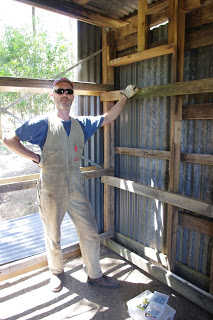 |
| The author constructs a timber frame on the inside of the old chicken shed in order to attach the internal steel cladding |
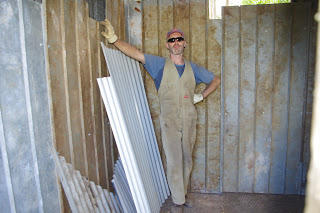 |
| The internal steel cladding was installed onto the timber frame |
The internal steel cladding took an hour or so to attach to the timber frame. Observant readers will note that in the corners, I have bent and wrapped the steel lining so that it curves around the corners. This process provides immense bracing strength and rigidity to the shed. Bending the steel sheets was quite a difficult process as I had to attach one edge of the steel sheet to a wall, and then – with a few potty mouthed expletives – kicked and punched the steel so that it fitted snugly into the corner of the shed. Then before the steel sheet had a chance to bounce back and away from the corner, I quickly put a few heavy duty screws through the steel sheeting and into the timber frame behind it.
The internal steel sheets are all scrap sheets from other projects and as such they finish at different heights. The differing height of the internal steel cladding is fine because I generally prefer not to stack firewood higher than my shoulder height. If firewood was stacked higher than my shoulder height and it fell on me, there is a risk that it could lead to serious injuries.
 |
| The external steel cladding on the firewood shed was also installed |
Once the inside of the firewood shed was completed, I could then complete installing the external steel cladding. Those external steel cladding sheets are also wrapped around the corners of the shed and this not only provides excellent bracing, it also has the benefit of being weather proof.
The next day’s work saw the steel guttering installed (to collect any rain that may eventually fall onto the roof), as well as the pipes to take that rainwater and store it in the small 2,100 litre (550 gallon) dark green water tank on the downhill side of the shed. An overflow pipe was fitted to that water tank so if the water tank became too full, any water would drain away to a nearby grove of Blackwood trees (Acacia Melanoxylon). That water tank also now has a standard garden tap attached to it too!
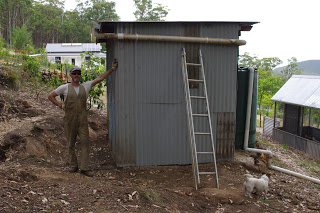 |
| The rainwater harvesting systems have been connected up to the new firewood shed |
I reckon the shed has considerable character and charm! In the photo above you can see that even Scritchy the boss dog approves of the repurposing.
Over the next few weeks, I’ll landscape around the shed and also fill it with split and seasoned firewood.
The summer heat has been extreme and other than the chickens run (edit – due to sprinkler-gate), everywhere else is quite dry. To ensure that the fruit trees in the orchard aren’t too stressed by the dry and hot conditions I brought more manure onto the farm this week. The manure gets placed around the trunks of the fruit trees and all competing vegetation is completely removed. The fruit trees respond really well to the feed and removal of competition and even without any additional watering they are showing new growth. So far I’ve fed about 90% of the orchard trees and there is probably about another days work before this job is completed. Observant readers will note some fruit trees in the background of the photo below and to the right hand side have not yet received this treatment.
 |
| More fruit trees in the orchard had manure applied to around their trunks and the competing vegetation was also removed this week |
The other day, the editor and I travelled up into a secluded part of the mountain range at higher elevation to enjoy a picnic and escape the midday heat. I mentioned to Pam (a regular commenter here) a few days ago that in this particular picnic ground there was a huge Elm tree, but on closer inspection the tree turned out to actually be a giant Linden Tree which was in full flower, smelled beautiful and was absolutely covered with buzzing bees. Don’t take my word for the size of the tree, check out the photo below:
 |
| A huge Linden tree lives in a secluded picnic spot high up in this mountain range |
Near that Linden tree there is a truly massive specimen of a Mountain Ash tree (Eucalyptus Regnans). Regnans is Latin for the English word “Reigning” and that is because these are the largest flowering plants in the world and are only beaten in height these days by the Californian Redwoods. There were many credible reports that at the time of European settlement, a few of the Mountain Ash trees were actually larger than the biggest of the Californian Redwood trees, but they were cut down. Anyway, this Mountain Ash tree is still alive, but was left in peace because it has a hollow core and the top had fallen off at some stage in the far distant past:
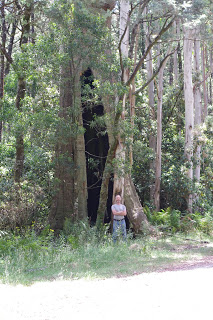 |
| This huge Mountain Ash tree which I reckon has one of the widest girths of any tree in the mountain range |
Observant readers will note the tall grey trunked trees in the background and to the right hand side of the photo. Those are also Mountain Ash trees which are regrowth from the January 1983 Ash Wednesday bushfires. It is pretty awesome to consider just how old that huge Mountain Ash tree may actually be.
The extreme heat and constant threat of bushfires has meant that we have been living with the bushfire shutters covering the toughened glass windows.
 |
| Sir Scruffy checks to see whether the bushfire shutters are correctly covering the windows |
On the veranda further back you can see steel table and a couple of chairs and most evenings after a hard day’s work, the editor and I enjoy a coffee and biscuit while we watch the goings on in the valley below.
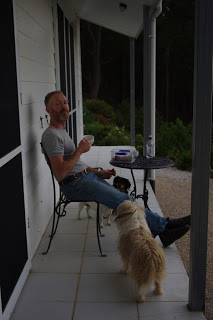 |
| The author and dogs enjoying a coffee and biscuit after a hard day’s work |
The ongoing heat has produced an amazing quantity of flowers in the herb beds and I’ve noticed that the mint plants are just now starting to produce some flowers. Over the next week or so, I’ll set up a page on this blog (once I work out how to do so!) where I’ll show all of the various flowers that the European honey bees enjoy and at what time of the year. Those honey bees are quite selective in their tastes and they don’t consume from every flowering plant. I’ll leave a note when this project is done and expect it to be updated regularly.
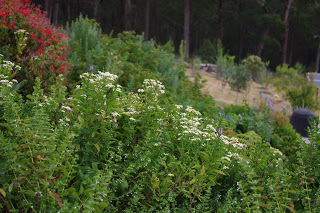 |
| The extreme heat has produced lots of herb flowers |
The apricots finally ripened this week and I have been enjoying sun ripened apricots with my breakfast muesli.
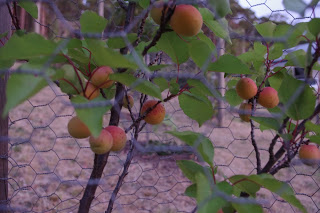 |
| The apricots finally ripened this week and were all harvested |
The tomatoes are very early this year and over the past week I’ve spotted the first of the many tomato fruits slowly starting to ripen.
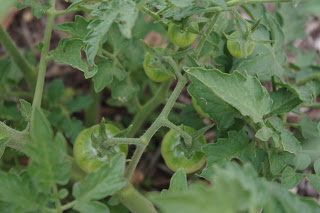 |
| I spotted the first green tomatoes this week |
Zucchini (courgettes) fruit are starting to swell on the vine and it looks as though it will be a bumper crop this year. There are a lot of other pumpkins and melons growing about the place, but the zucchini plants seem to be way ahead of the pack.
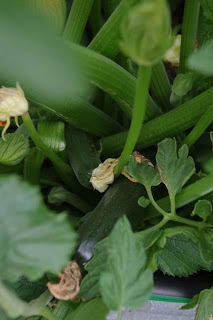 |
| Zucchini (courgettes) fruit are starting to swell on the vine |
I always like finding new and interesting wildlife, and this week the stick insects made an appearance. Sometimes, the stick insects are bright green and at other times they are brown like the one below. To put the size of the insect into some sort of context, the timber frame is 90mm x 45mm pine (otherwise known elsewhere as a 2 by 4).
 |
| A huge stick insect has been hanging around the house eating other insects this week |
Over the past week, on hot afternoons an Echidna has been snuffling around the orchard and the other day I took this photo of the little fella next to a huge tree.
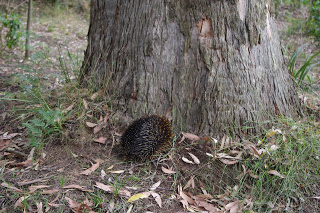 |
| This Echidna has been seen snuffling around the orchard on hot afternoons this week |
The temperature outside now at about 6.30pm is an rainy, overcast and very cool 14.9’C degrees Celsius (58.8’F). Although it is raining outside right now, there has been no officially recorded rainfall, but last year ended up with a total of 740.0mm (29.1 inches).
Posted by Cherokee Organics at 18:59
Monday, 11 January 2016
This summer has been hot. For a while now, the only rain has been that of the dry, dead leaves floating through to the ground as they are driven from the arms of the tall trees by even the lightest of breezes. Those leaves gather on the ground and as you step through them, your footsteps echo with the sound of crunching and the unmistakable smell of eucalyptus oil. During the middle of the day the cicadas loudly call to one another from their burrows, other insects buzz around and the birds are silent. The air smells dry and dust is gathering everywhere. It’s hot.
With about half of summer left to go, the editor and I have been conserving our water resources carefully and despite having to water the various plants, my best guess is that I still have about 75% of the total water capacity remaining.
The orchard has mostly struggled through the summer with no additional watering, as have most of the herbs. The annual, short lived plants that don’t have the deep root systems of longer lived plants have required most of the watering. Of those annual plants grown, none are thirstier than the tomatoes. But I do love eating fresh tomatoes as nothing beats fresh home grown tomatoes for taste. Every week as summer gets longer and hotter, I’ve spent more time every day watering the tomatoes, so last week I installed a sprinkler to assist with that job.
The sprinkler proved to be such a good idea that earlier this week I also added a permanent standard garden tap on the inside of the berry and tomato enclosure. Adding a new garden tap means a lot of digging in the hot sun. It’s hot. Firstly, you have to find the original water pipe line and then dig a trench from that existing water pipe to the location of the new garden tap.
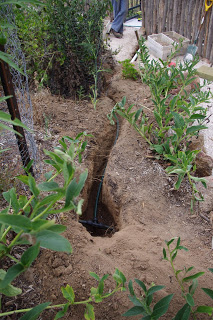 |
| A new water pipe has been connected up from the existing water pipes to a brand new garden tap in the berry enclosure |
Observant readers will note just how dry the soil is in that garden bed. That garden bed is less than a year old and I’ve observed that it usually takes about two to three years and a huge amount of organic matter before the soil is good enough that most plants will thrive during even the hottest and driest summers.
The new water pipe travels under a walking path, so that water pipe sits inside another much larger 50mm (2 inch) diameter pipe so that walking traffic on the path does not damage the water pipe.
By early afternoon the new garden tap was connected up.
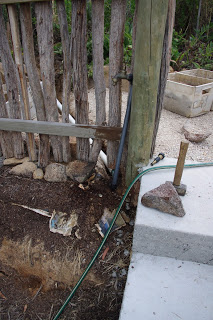 |
| The new garden tap had been connected up to the water system and was ready to be tested for leaks |
The garden tap was permanently fixed to the treated pine timber post. I then connected the sprinkler up to that new garden tap using a short length of hose and tested all of the connections for leaks. By late afternoon, I was feeling pretty chuffed with my ingenuity because now all I know had to do to water the tomatoes was turn on the tap and (and also remember to turn it off a few minutes later).
I thought to myself: How clever am I?
Alas, all good things come to a swift end – including my self-congratulatory frame of mind because the sprinkler decided that my ego was too fluffy optimal and the sprinkler promptly fell apart. No matter how many times I reassembled the sprinkler, it fell apart again. And just to convince me what a bad idea the sprinkler was the ratchet mechanism decided to stop working too. I’m trying hard to keep this blog family friendly so I won’t share the highly expressive and very colourful language that I used to describe the now dead sprinkler.
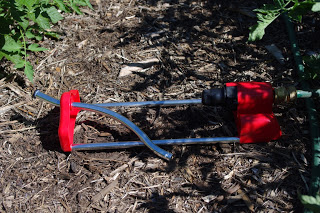 |
| A sad day for the two week old and now completely broken sprinkler |
And I didn’t have a receipt for the rotten thing because I had paid cash and left the store with the foolish belief that there was no probability that such a simple machine could possibly break. Oh well, back to hand watering.
The tomatoes hardly seem to notice whether they are hand watered or watered by the sprinkler, because they are growing very strongly.
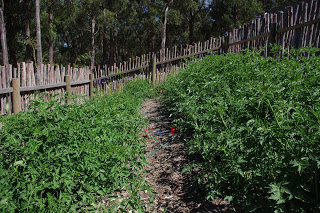 |
| Tomato Cam™ tells no lies and the tomatoes have grown massively in the past week and are full of ripening fruit |
The gremlins must certainly have worked their way into the water systems this week because I also experimented with a soaker hose on the raised vegetable beds. Truth is stranger than fiction because the soaker hose worked for at least five minutes and then the seal at the end of the pipe broke:
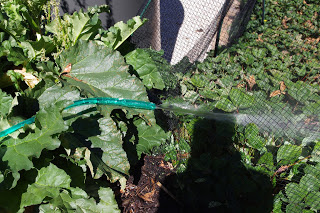 |
| The seal at the very end of the soaker pipe broke and the strawberries celebrated because of all of the extra watering |
At least I was smart enough this time to obtain a receipt, so that soaker hose will shortly be returned to the retailer.
You’d think that the plastic water gremlins stopped there, but alas no! During summer, I test the bushfire sprinklers every week. Most of the bushfire sprinklers are metal, but there are a couple that are plastic. This week, two of the plastic bushfire sprinklers seized up and failed. I’m a little bit in awe of those gremlins as they seem to be wreaking havoc.
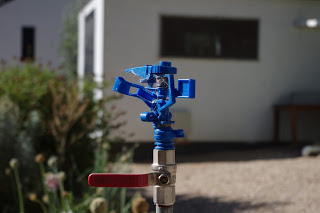 |
| This plastic bushfire sprinkler seized up this week |
Confrontations can’t be avoided and gremlins have to be dealt too. After an extensive investigation, I’ve discovered that brass and stainless steel are fatal to their tricksy gremlin ways (edit: gremlin kryptonite perhaps?). The plastic sprinkler heads were replaced with solid brass sprinklers with stainless steel components. All was then good – apart from the other plastic rubbish that had failed and has yet to be replaced.
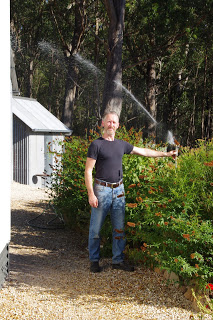 |
| Brass and stainless steel bushfire sprinklers have now replaced the dodgy plastic sprinklers |
Overseas readers may not be aware, but in the state of Western Australia there is a huge bushfire raging: WA fires: Conditions ease in blaze which claimed two lives, razed Yarloop
With the ongoing threat of large scale bushfires, the editor and I have been this week doubling our efforts and we have chopped and dropped a large cleared area around the house. The interesting thing to note is that the chop and drop process produces a fine layer of mulch and you can see the retained soil moisture – despite the lack of rain – by simply scratching away the surface of the mulch. Six years ago, the area in the photo below was a solid clay pan with no organic matter where any rainfall ran over the ground. The other interesting thing to note is the very large tree in the centre of the photo with the impressive buttressing still bears the scars of the January 1983 Ash Wednesday bushfires.
 |
| The editor and I have chopped and dropped a lot of vegetation this week due to the extreme bushfire risk |
During that time, we stumbled across this tiny Pin Oak seedling. It received a cage to protect it from the wallabies as well as a decent feed of manure (and a bit of water too):
 |
| We came across this tiny Pin Oak seedling this week and decided to protect it from the wallabies |
Observant readers will note just how much fallen dry leaf litter there is on the ground prior to the chop and drop mulching process. It is sort of funny, but leaf fall here is high summer, rather than the more expected autumn. Autumn is the time when all of the native trees are rapidly growing and setting down strong root systems instead!
There are all sorts of surprises to be found in the surrounding forest as I spotted a very large white brain like fungi growing high up in one of the oldest trees on the farm. I was going to call this week’s blog “Tree brains” or “Brain forest”, but what with all of the gremlins, I can’t really afford to attract any zombies as well.
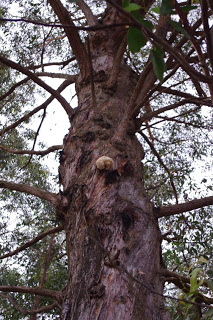 |
| A huge white brain like fungus is growing high up on the side of one of the oldest trees here |
It has been so hot and still this week that I thought that it was time I took a look inside the experimental bee hive to see what was going on. I’ve been keeping a close eye on them every few days through the observation pane on the hive, but conditions were fluffy optimal to open the very young hive so…
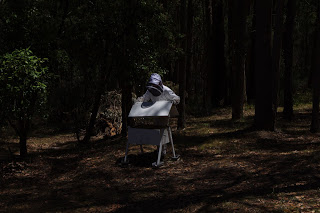 |
| This week I opened up the experimental hive to check on the progress of the young European honey bee colony |
The European honey bees have to heat their hive to quite a warm temperature and I’d been a bit overly optimistic at how fast the young colony would expand into their new hive, so I reduced the size of the hive by about four frames which were empty anyway. Reducing the size of the experimental hive is as simple as moving the thick follower boards on each side of the occupied frames in the hive. A smaller hive allows the bees to keep that smaller area more easily warm for raising brood which means that they will use less energy, which means they will be less stressed.
 |
| The young hive now occupies a much smaller area in the experimental bee hive |
You can see the two follower boards in the above photo because they sit up above the height of the many frames on either side of the occupied frames. The colony now has a spare empty frame on each side of the occupied frames. From observing various bee hives over the past few years, my gut feeling is that a lot of the problems that we inflict on the European honey bee are a result of over harvesting of the honey. We simply have too great of an expectation of the European honey bees productive output and that places the species under considerable stress.
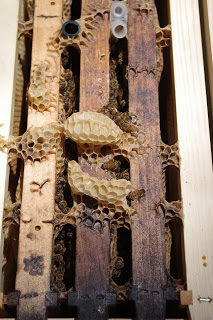 |
| The healthy looking but still very young experimental bee hive |
A number of commenters have asked me about the sort of flowers that the European honey bees enjoy at the farm. Rather than repeating that information here and there amongst the various blog entries, I have added a page on this blog devoted specifically to that subject. If anyone has any suggestions regarding that page, please drop me a comment. The page can be found on the right hand side of the blog by clicking on the text: Flowers that European Honey Bees like at the Farm.
The fruit trees this week have just started to produce ripe plums. Not only are plum trees the hardiest fruit trees around, they also produce delicious stone fruit. This week I picked the Angelina plums:
 |
| Angelina plums became ready to pick for fresh eating this week |
Tonight a storm rolled through the Victorian central highlands and after a day where the temperature in the shade was just shy of 37’C (100’F), the temperature outside now at about 8.30pm is an enjoyable, overcast and very cool 17.3’C degrees Celsius (63.1’F). The house is wide open to receive that cool evening air and the birds are singing to each other outside! So far this year there has been 1.8mm (0.1 inches) of rainfall which is up from last week’s total of 0.0mm (0.0 inches). Hey, don’t laugh I really enjoyed that small amount of rainfall when it arrived, but I’ve become so used to the heat that I’m starting to shiver now in the cooler night air!
Posted by Cherokee Organics at 21:35
Monday, 18 January 2016
A gentle lapping of the waves. Sun warms your skin and later burns. Gulls lazily whirl in the air calling out to you for an easy feed. Cold water shocks as it first hits your body. Hot sand burns beneath your feet. The occasional cooling breeze drifts in from the water and brings the smell of salt on the air. Ice creams and cold drinks provide relief from the heat.
It would have been nice having a day at the beach, instead this week I was up in the mountains and forests of this south eastern corner of the Australian continent. That however doesn’t mean that I can’t throw a beach party at the farm! And the European honey bees this week were the lucky recipients of that beach party.
The heat has been unrelenting this summer and so every day I provide water for all of the insects, birds and animals (and every other living thing on the farm) in different spots on the farm. The European honey bees finally discovered the birds water supply and so I threw those bees a beach party by adding more water during the late afternoon! There are even a few small waves in that birds water supply for the bees to enjoy.
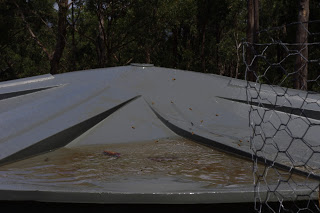 |
| This week the European honey bees finally discovered the birds water supply |
In this part of the world, the heat brings bushfires and this year is no exception. The only upside from those bushfires is that the massive amount of air pollution tends to produce the most amazing sunsets:
 |
| Air pollution from the many recent bushfires produces the most amazing sunsets |
We’re now three weeks out from the summer solstice and I feel that change is in the air, maybe.
It is still hot though. Last Wednesday showed a temperature in the shade of 41.6’C (106.9’F):
 |
| Last Wednesday’s temperature of 41.6’C (106.9’F) |
And then it blew really cold. At about the same time the very next day after a cool change dropped the outside temperature to 8.6’C (47.5’F).
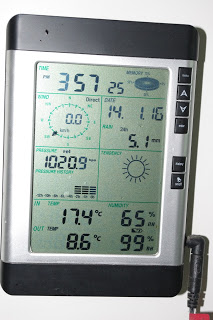 |
| Last Thursday’s temperature of 8.6’C (47.5’F) |
Not to worry though as today it was hot again with a maximum of 36’C (96.8’F).
When the cold change came through I realised just how accustomed to the heat that I’d become. In the evenings I usually let the chicken’s free roam around the orchard. But it was so cold that day, that I remarked to the editor that the chicken’s would definitely not be free roaming through the orchard that evening. Alright I do have to fess up at this point as I had used some very colourful potty mouthed expletives that shall not be repeated here (remember we’re trying hard to keep this blog family friendly!)…
One day the European honey bees were enjoying a beach party in the very hot sun, the next day they refused to make an appearance and instead kept to their warm and toasty hives! As a fun fact, my understanding is that the bees will not generally leave their hives to forage when the air temperature is less than 10’C (50’F).
Regular readers will recall that I have been previously having troubles with the plastic bushfire sprinklers because they had seized up and so I had replaced those plastic sprinklers with brass and stainless steel mechanisms. There are five bushfire sprinklers permanently set up and ready to run at a moments notice. Of those five bushfire sprinklers, one was not working correctly – even with the new brass and stainless steel sprinkler head. It was a complete mystery to me.
In such circumstances when presented with a mystery of this sort, I compare the individual components of similar systems that actually do work to the components in the system that do not work. The next step in the process is for me to gain an understanding of how each component in the system should work.
And what I found alarmed me. Most water systems use valves. A valve is a fancy name for what is also known elsewhere as a tap or a spigot. The job of a valve is simply to shut off the flow of water at that point in the pipe. Without valves, most water storages would soon be completely drained because there would be no way to stop any stored water flowing out of the water pipes leading from the water storage (i.e. water tank, water pipe, dam or pond).
The problem with the bushfire sprinkler was with the valve used to turn the sprinkler on or off. It had been a few years since I’d purchased a half inch valve and in that time in order to save costs, the manufacturers of those valves had reduced the thread from 18mm (0.7 inch) to 12mm (0.47 inch) and the bushfire sprinkler mechanism was jamming in the now much shorter thread.
I even travelled to a few different local suppliers to confirm that the shorter 12mm (0.47 inch) thread on the half inch valve was now the new standard. The bushfire sprinkler would not work without a larger thread, so I had to purchase a hex nipple and an equal socket to add to the valve and now the bushfire sprinkler works perfectly. What a nuisance.
The photos tell it all:
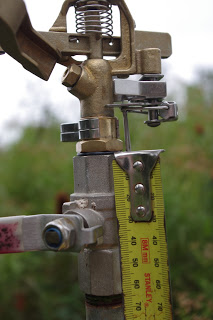 |
| An older half inch valve with an 18mm (0.7 inch) thread |
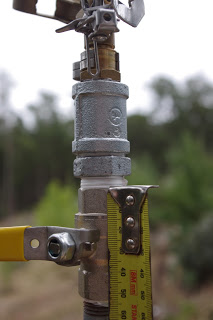 |
| A newer half inch valve with a 12mm (0.47 inch) thread. A hex nipple and an equal socket ensures that the bushfire sprinkler works |
There were no days at the beach for me this week as the work on converting the old chicken shed into a firewood storage shed continued. The brief change to cooler weather meant that the very arduous task of landscaping around the new firewood shed could take place without falling over from heat exhaustion.
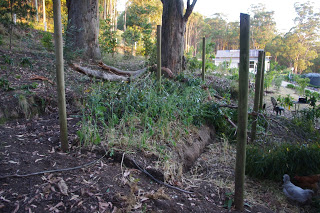 |
| The area behind the old chicken shed had three terraces cut into the clay. Two of which can be seen in this photo |
The area behind the chicken shed originally had three terraces cut into the clay. The terraces were there when I purchased the block of land and local history has it that an old shed used to sit on that site. The shed was used as a shelter from the weather by the old timber getters that worked this area. The shed had clearly been destroyed in the Ash Wednesday bushfires that swept through this mountain range back in January 1983. As I dug into the clay this week I extracted all manner of useless rubbish. As an interesting side note, a few years ago I unearthed and removed the remains of an old 1940’s looking burnt out vehicle not far from this site.
It had always been the plan to remove the terraces and restore a more natural looking slope above the chicken shed. However removing the terraces meant a lot of digging and moving of clay (i.e. hard work). The job also involved mixing in the many years of chicken manure that formed a very decent looking soil on those terraces.
After the entire day from the morning into the early evening spent digging and moving soil, the job was done and the site looked pretty neat and now you’d never even know the terraces used to exist.
 |
| After a long day of digging and moving soil by hand, the terraces have undergone a disappearing act! |
There is no where’s Toothy? in this week’s blog because this week we can play: where’s fluffy? There is a small white Silky chicken in the above photo.
The very next day, I spread a cubic metre (about 1.3 cubic yards) of manure over the area so that when it does actually rain again the soil formation processes will begin. Hopefully over autumn and winter that area will be planted with a mix of small shrubs and flowering plants.
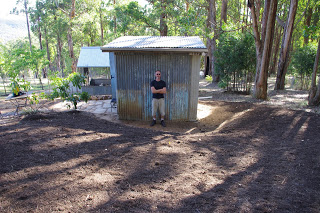 |
| The recently landscaped area above the old chicken shed received a cubic metre (1.3 cubic yards) of manure. |
The editor and I didn’t get to enjoy a day at the beach this week because we were cutting, splitting and storing next winter’s firewood in that new firewood shed. At the end of another long day the new shed was about 90% full of seasoned firewood.
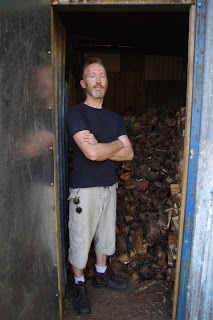 |
| The new firewood shed was about 90% full after a day of cutting, splitting and storing firewood |
Observant readers will note two things about the above photo. Firstly, I’m looking quite flushed after a hot day of work. And secondly, just as the photo was about to be taken a cheeky house fly landed on my forehead!
The chickens enjoyed the leftover organic material and massive quantity of insects from the area that the seasoning firewood had been removed from.
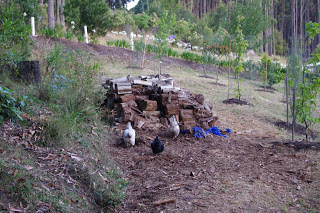 |
| Chickens enjoying the leftover organic material and massive quantity of insects from the area that the seasoning firewood had been removed from |
A rough estimation of the water storages on hand today showed me that they were about 70% full, which I’m pretty happy with given how hot and dry the summer has been. In the past week or so, I have started giving some of those water reserves to the plants. The zucchini (courgettes) have been enjoying the combination of extra water and serious heat.
 |
| The zucchini (courgettes) have grown incredibly this week |
Plenty of the plants here are very drought and heat hardy and the agapanthus and oregano (mint family) plants are some of my (and the European honey bees) favourites. In the photo below on the middle left you can also see a very large local fern (Dicksonia Antarctica) which is also very heat and drought hardy despite its Latin name.
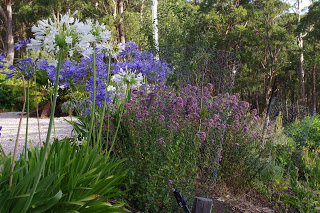 |
| The agapanthus and oregano plants love the dry and heat and are flowering in profusion |
The garden beds immediately below the house have not been watered this season and they are flourishing just on the usual rainfall due to the very heavy feeding that I have provided them in recent years. Those garden beds also provide lots of habitat for the many small birds, insects, arachnids, and reptiles that live in them.
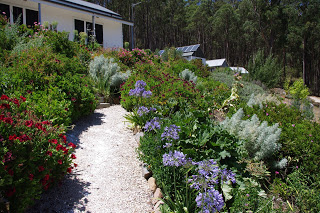 |
| The garden beds immediately below the house have flourished despite the heat and low rainfall |
The experiment with the coffee shrub in this cool temperate climate has been a bit of a struggle because I planted it just prior to the first heatwave so whilst the shrub doesn’t look like it has enjoyed a relaxing summer at the beach, it isn’t dead either…
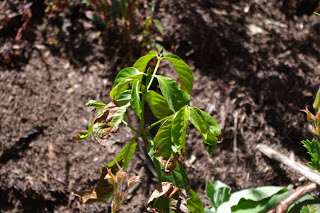 |
| The coffee shrub is looking a bit distressed by the heat and lack of rainfall, but at least it isn’t dead! |
The stone fruit is coming to an end this year about one to two months early because the additional heat has simply assisted with ripening the fruit. The plums are one of the final stone fruit trees to bear fruit and the fruit on this King Billy plum tree is almost perfectly sun ripened and ready to be picked.
 |
| The fruit on this King Billy plum tree is almost perfectly sun ripened |
The next really big crop is tomatoes and the photo below shows just how much the tomatoes have grown since last week:
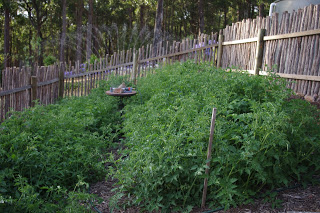 |
| Tomato Cam™ shows just how much the tomatoes have grown since last week |
Observant readers will note the replacement locally made sprinkler which now has to be placed on an elevated position on a table so that the water is spread evenly through the enclosure.
The cherry tomatoes are starting to really swell and put on some size. I expect that the first of the ripe tomatoes may be ready sometime in early February.
 |
| The cherry tomatoes are starting to really swell and put on some size |
The temperature outside now at about 10.00pm is an enjoyable 17.4’C degrees Celsius (63.3’F). So far this year there has been 7.8mm (0.3 inches) of rainfall which is up from last week’s total 1.8mm (0.1 inches).
Posted by Cherokee Organics at 22:42
Monday, 25 January 2016
Accidentally Hugelkultur
Summer storms roll in quickly. Thick clouds scud across the sky. If the storm is big enough, the clouds will hover and scrape just above the land and they can certainly get stuck in the mountains here where they swirl and form fog and mist. And just before those clouds deliver their precious rain, a strong wind usually blows the hot air trapped under those clouds to somewhere else. And that is exactly what happened this week.
Earlier this week, I was hoping to catch a glimpse of a once in a decade alignment of five of the planets. The night sky is usually quite clear and it would have looked very cool. However, that night thick clouds built up over the farm. The clouds were the tail end of a tropical storm which stretched all the way down from its origins in the oceans to the north west of the continent. The clouds did look cool though as the moon peeked through:
 |
| The moon peeks through the thick clouds building up over the farm |
The moon is always interesting to see here during summer because the pollution in the air from the frequent bushfires creates an orange and/or red circle at a slight distance away from the moon. Part of that circle can be seen in the photo below the moon.
I breathed a small sigh of relief this week as those dark clouds brought with them a little bit of rain. What was even better about the rain was that it fell very slowly and was spread over a number of days. Those rainy days can be described as: ‘It rained a lot, but we didn’t get much rain!’
Slow rain is always the best type of rain during long hot summers because the water has a chance to infiltrate into the ground. On really hot and dry summers, the soil can become water repellent (or technically speaking hydrophobic). With hydrophobic soils water will run over the top of the soil and roll away as if it were liquid mercury. It can be quite a common problem in Australia and is treated through the application of mulches, composts and manures or even deep ripping of the soil.
Anyway, after a few days of rain cold and mists, Poopy the Pomeranian (yes we all now know he is a Swedish Lapphund, but don’t tell him about his ancestry as he may start taking on airs and graces!) had decided that the outside conditions were a bit sub fluffy optimal:
 |
| Poopy the Pomeranian declares that the weather is now sub fluffy optimal |
It takes a bit more than a slow summer storm to derail the juggernaut that is Fernglade Farm, and so this week the new firewood shed was completely filled with cut and split timber, ready for serious cold weather – not merely this temporary cooler weather aberration!
And it was whilst I was splitting and storing the seasoned firewood this week that I had the realisation that I had become the Accidental Hugelkultur dude. Seriously!
For the readers that have no idea what I’m talking about: Hugelkultur is the art and science of turning timber into soil. The concept is really that simple and the next photo shows the process of converting timber into soil.
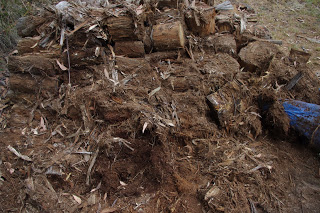 |
| A view into the guts of the firewood pile that was left to season for three years |
Ordinarily, timber and leaves from Eucalyptus species takes an inordinate amount of time for them to break down into fine soil. The difference here in the firewood pile was that the logs were cut into firewood lengths which increased the surface area of the timber. Also those firewood lengths were then placed onto a plastic tarp (which is the blue tarp in the above photo). My original thinking was that the blue tarp would reduce the amount of moisture in the seasoning firewood by acting as a moisture barrier. Instead the tarp had the opposite effect in that it trapped moisture and so the bottom layers of seasoning firewood were actually far wetter than they would otherwise be if they were just sitting on the soil. The increased moisture in the seasoning firewood meant that every fungi and insect in this area turned the bottom layers of stored seasoning firewood into quality soil. The trapped moisture means that despite the hot weather this year you don’t even need clouds and rain to keep that firewood pile damp!
 |
| Close up photo of the rapid conversion of firewood sized logs into top quality soil |
I recovered all of the firewood that I possibly could for storage in the two firewood sheds and then distributed the newly developing soil over a large area that had previously had the seasoning firewood sitting on it. The editor has decided to plant a new garden bed in the slight incline behind that now cleared area. A very large rock was levered into position as the very first rock in that new rock wall. It is all starting to look neat:
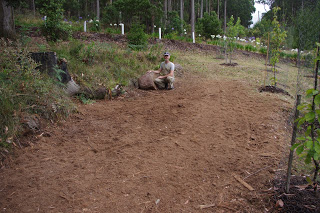 |
| The area that contained the stored firewood has now been cleaned up and the very first large rock has been placed into a future rock wall and garden bed |
Every evening since then the chickens have been happily rummaging through that distributed soil looking for all manner of unmentionable yet tasty things.
 |
| The chickens work their way towards the distributed soil from the firewood pile |
Splitting the timber in the seasoning firewood pile produces a lot of bark and sawdust, which I collect and place in natural depressions in the orchard (edit: filling up holes). In the photo below you can see a Plumcot fruit tree enjoying the additional organic matter placed into a depression next to it.
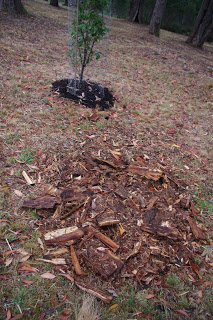 |
| The detritus from the firewood splitting process is placed into a depression in the orchard as feed for a Plumcot fruit tree |
The new firewood shed has now been completely filled and I’ve now commenced filling the original firewood shed with the remaining split timber from that firewood pile.
The next task was to place rock toppings from a local limestone quarry around the newly commissioned firewood shed. The toppings provide an all-weather surface, but really, I just don’t like mud!
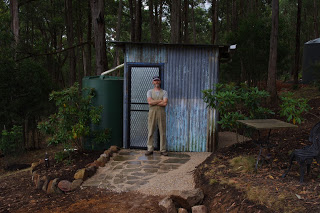 |
| Rock toppings from a local quarry were placed around the new firewood shed |
The toppings provide for an all-weather walkway around the new firewood shed.
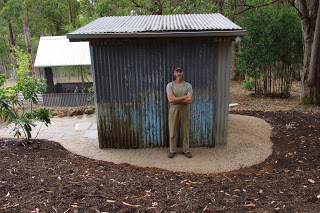 |
| Rock toppings provide for an all-weather walkway around the new firewood shed |
It wasn’t only Poopy the Pomeranian who decided that the recent cooler and damper weather was sub fluffy optimal, because Stumpy the Wallaby also became rather annoyed by the weather and decided the best way to display her annoyance was to assist with an impromptu pruning job on a four year old apple tree. I had only removed the apple tree from its wallaby proof cage a few months earlier too! Fortunately Stumpy the Wallaby hasn’t taken out the main trunk of the fruit tree.
 |
| Stumpy the Wallaby assists with pruning the lower branches of this four year old apple tree |
Despite the clouds and rain, the flowers are putting on a good display with the mints (Oregano in the photo below) and the long flowering Agapanthus all providing a huge quantity of feed for the bees:
 |
| The Oregano and Agapanthus are putting on a good flower display this summer and providing plenty of feed for the bees |
And whilst we are discussing the European honey bees, the new young colony in the experimental hive is doing well and ever so slowly expanding. Now that I can observe a young bee colony, I can see just how long it takes for the colony to become established. It is a slow process.
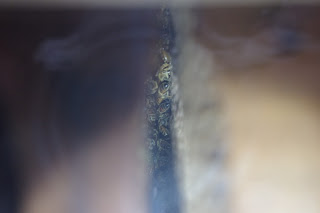 |
| The new young European bee colony in the experimental hive is doing well and ever so slowly expanding |
I couldn’t resist adding in the next photo of swelling apples on a young apple tree, just after the rain. There are 26 varieties of apple trees in the orchard and they are the hardiest and most reliable of all of the fruit trees. It seems as if every year there is more produce from these apple trees.
 |
| Swelling apples on a young apple tree, just after the rain |
Lately with the extreme hot weather, the gremlins have been wreaking havoc with many tools and appliances here. The now much cooler and cloudy weather has had me breathing a sigh of relief on that front. But that was not before my trusty and much loved outside portable electric oven died. Honestly, the death notice hadn’t even been placed in the newspaper before the locals had begun inspecting the real estate and I spotted this praying-mantis checking the dead oven out as a potential new home:
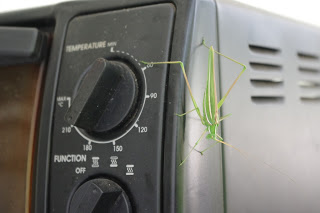 |
| A praying-mantis checks out the recently deceased portable oven as a potential new home |
In order to extend the life of the various bits of technology that I use on the farm, the editor and I have developed a maintenance list of what tasks are required to be undertaken in each particular month of the year. Water pumps are one item of technology that are invaluable and the maintenance schedule had them listed for inspection and cleaning this month.
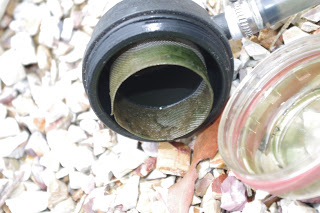 |
| The water pumps were all inspected this week and the stainless steel mesh filters were all cleaned |
Observant readers will note that the above photo of the stainless steel mesh filters for one of the water pumps is covered in algae. The mesh is worthwhile cleaning as a regular maintenance item because as the algae increases in coverage and thickness on the water pump mesh filter, it slows the flow of water through the pump (the fancy technical name for that part of the pump is the diaphragm chamber) and it increases the amount of work that the pump has to perform which will inevitably reduce its lifespan by burning out the motor.
There was a bit of discussion last week in the comments section about the Australian designed steel star picket – which is used for fencing, amongst other uses. A star picket is a Y shaped steel post which a person can bang into the ground using a hammer or mallet. It is quite a clever design because the steel post has holes in it to thread steel fencing wire. The other benefit of the star picket is that it can produce quite durable and cheap fencing which is also quick to establish.
Star pickets are designed and constructed to resist the pressures that large animals can place on them, and I find them almost impossible to remove from the ground. However, I have a very heavy duty tool which can grab onto the star picket and lever it up and out of the ground and I demonstrate its use in the photo below:
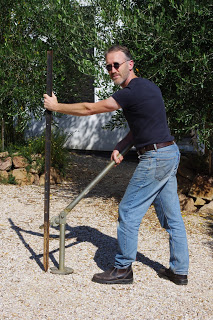 |
| The author showing a star picket removal tool in action |
It is a clever tool, is it not?
Oh yeah, just quickly and this has absolutely nothing at all to do with the blog, but it is a long standing personal interest of mine. As some of the regular readers may now know I’m something of a music nerd.
And tomorrow is Australia day which celebrates the landing of the First Fleet at Port Jackson way back in 1788 on January 26. They arrived during the midst of a drought.
The First Fleet was actually a convoy of ships which were sent by the English to set up an off shore penal colony for unwanted citizens. Seriously, the continent was settled by the Europeans as a prison. In those days it would have been akin to a one way ticket to Mars!
Some people reflect on Australia Day as Invasion day as it marks the point at which 90% of the indigenous population died through disease, murder and destruction of culture resulting from lack of access to their traditional lands. I understand their point of view.
On an altogether different and perhaps irreverent note, Australia day for me has long meant Triple J’s hottest 100 day. Triple J is the government national youth commercial free radio station and it is awesome. Every year since 1992, I’ve been enjoying the Hottest 100 songs of the previous year every Australia Day. It is important to note that the radio station – unlike most radio stations in the country – has a quota for Australian music and I also suspect that they have a quota for Female vocalists too.
Anyway, I thought I’d chuck in my predictions for tomorrows vote (warning some of the songs may contain adult themes and naughty words):
- The winner will be from the stoner rock category: Tame Impala – The Less I know the better, which is a song of unrequited love from the very talented Kevin Parker;
- From the pop song category, there is another song of unrequited love: Jarryd James – Do you Remember. There definitely must be something in the water for so many potent songs of unrequited love to be gaining airplay? I reckon it will score well;
- I reckon a prediction for the hip hop crowd: Illy – Swear Jar. Illy has a law degree and he’s up to his fifth album and I suspect he is now just grumpy, no doubt about it;
- For the ladies I can’t work out which band will achieve high ranking status between the bands and performers: Courtney Barnett; Alpine; Tkay Maidza; Chvrches; Meg Mac and Alison Wonderland – all excellent performers and I hope they all do well; and
- And one for the hardcore and metal heads: Bring Me The Horizon – True Friends. How can you ignore the lyrics: “Cos I’ll forget but I’ll never forgive you”… “True friends stab you in the front”. Powerful and slightly scary stuff, I hope I don’t meet them.
Anyway, you heard my predictions here first and the countdown can be streamed from midday (local time) tommorow over the internet at: http://www.abc.net.au/triplej/
The temperature outside now at about 9.00pm is a cool 13.0’C degrees Celsius (55.4’F). So far this year there has been 23.8mm (0.9 inches) of rainfall which is up from last week’s total 7.8mm (0.3 inches).
Posted by Cherokee Organics at 21:41